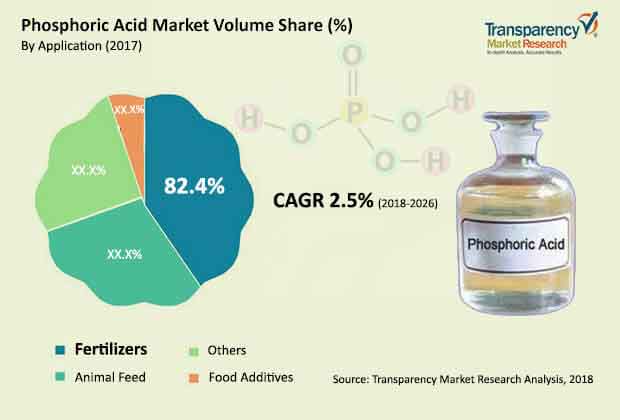
Phosphoric Acid Market – Snapshot
Phosphoric acid, also known as orthophosphoric acid, is a mineral and weak acid with chemical formula H3PO4. In terms of production value, phosphoric acid is the inorganic acid produced and consumed in the highest amount. In terms of volume, it is the second-most produced and consumed inorganic acid, after sulfuric acid. The leading use of phosphoric acid is in the manufacture of phosphate chemicals. Phosphoric acid can be produced by two commercial methods: wet process and thermal process. Wet process phosphoric acid is used in fertilizer production. Thermal process phosphoric acid is of higher purity and it is used in the manufacture of high-grade chemicals, pharmaceuticals, detergents, food products, beverages, and other non-fertilizer products.

Enquiry Before Buying:https://www.transparencymarketresearch.com/sample/sample.php?flag=EB&rep_id=2435
In a wet process facility, phosphoric acid is produced by reacting sulfuric acid (H2SO4) with the naturally occurring phosphate rock. The phosphate rock is dried, crushed, and then continuously fed into the reactor along with sulfuric acid. The reaction combines calcium from the phosphate rock with sulfate, forming calcium sulfate (CaSO4) and phosphoric acid.
The thermal process requires raw materials such as elemental (yellow) phosphorus, air, and water for the production of phosphoric acid. Following steps are used in the thermal process: combustion, hydration, and demisting. In combustion, liquid elemental phosphorus is burned (oxidized) in ambient air in a combustion chamber at temperatures ranging from 1650°C to 2760°C (from 3000°F to 5000°F) to form phosphorus pentoxide. Phosphorus pentoxide is then hydrated with dilute phosphoric acid or water to produce strong phosphoric acid in liquid form. Demisting removes the phosphoric acid mist from the combustion gas stream before releasing it into the atmosphere.
Request For Custom Research
https://www.transparencymarketresearch.com/sample/sample.php?flag=CR&rep_id=2435
The demand for phosphoric acid is primarily driven by the increasing demand for the production of phosphate fertilizers, which is closely related to the growing population worldwide. According to the UN Department of Economics & Social Affairs, the global population is expected to increase by two billion and reach 9.7 billion by 2050. The increasing population propels the demand for food, which is fulfilled by crops nourished with fertilizers. Developing countries and regions are using fertilizers at a much higher rate than developed countries. Phosphorus is an essential plant nutrient. It is uptaken by plant roots, usually as a dihydrogen phosphate ion (H2PO4-) derived from phosphoric acid (H3PO4). Fertilizers are used to compensate phosphorus deficiencies in the soil. Diammonium phosphate (DAP), monoammonium phosphate (MAP), and trisodium phosphate (TSP) are three important fertilizers derived from phosphoric acid, which are used across the globe to increase the crop yield and satisfy the increasing demand for food. Diammonium phosphate fertilizers are rich in mineral phosphorus. They are widely used in the production of grain and row crops (such as corn, wheat, rye) and some lawn grasses. Thus, increase in the demand for phosphate fertilizers boosts the demand for phosphoric acid.
Buy Now :https://www.transparencymarketresearch.com/checkout.php?rep_id=2435<ype=S
The environmental impact of phosphoric acid and phosphates in general has been investigated over the years and with the recent and relatively clear results, regulations have been imposed on the use of these chemicals. Phosphates and phosphoric acid affect water systems and pollute the water. High usage of phosphates in water bodies leads to an imbalanced water system. Phosphates provide nutrients to plants in a water body such as floating algae, which results in their abrupt growth. This decreases the supply of oxygen to animals in the water body. The entire cycle causes an imbalance, harming the human life, as humans rely on water bodies for sustenance. This cycle of pollution is a well-documented fact and is also the reason why phosphoric acid are being heavily regulated and banned in several regions across the world. Thus, the environmental impact of phosphates hampers the market for phosphoric acid.
Due to the rising demand for food, quality of crops needs to be improved and crop production needs to be increased. This is achieved by using phosphate fertilizers on crops. This, in turn, fulfills the global food demand.
Explore Transparency Market Research’s award-winning coverage of the global Industry:https://www.prnewswire.com/news-releases/strict-food-safety-regulations-in-north-america-and-europe-to-present-ample-business-opportunities-for-the-food-ingredients-sterilization-market-advent-of-technological-innovations-to-widen-scope-of-the-market-tmr-301268926.html
About Us :
Transparency Market Research is a global market intelligence company, providing global business information reports and services. Our exclusive blend of quantitative forecasting and trends analysis provides forward-looking insight for thousands of decision makers. Our experienced team of Analysts, Researchers, and Consultants, use proprietary data sources and various tools and techniques to gather, and analyze information.
Our data repository is continuously updated and revised by a team of research experts, so that it always reflects the latest trends and information. With a broad research and analysis capability, Transparency Market Research employs rigorous primary and secondary research techniques in developing distinctive data sets and research material for business reports.





